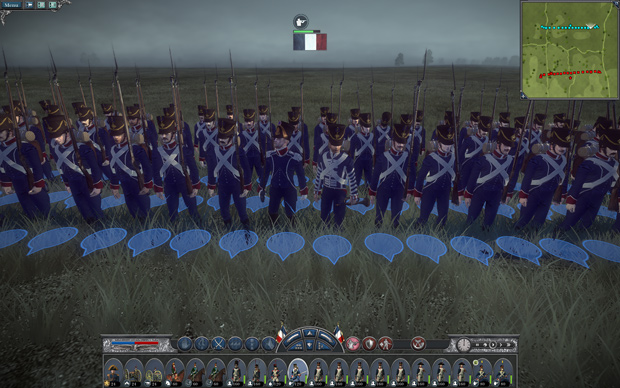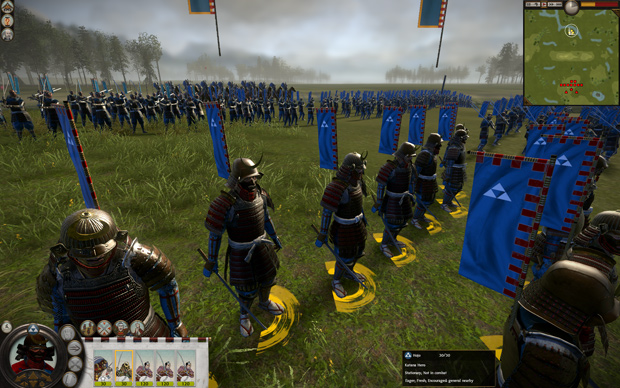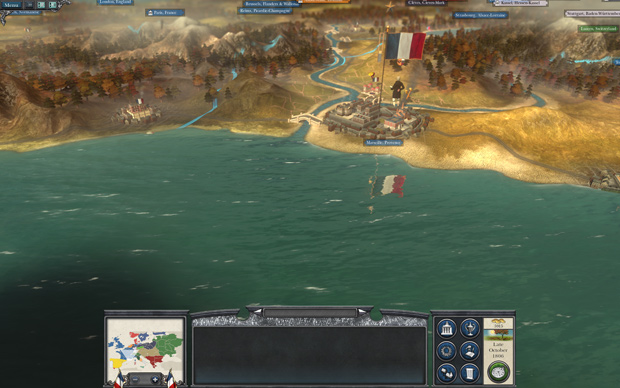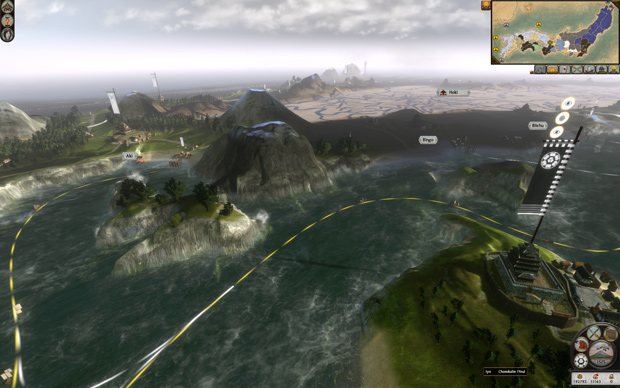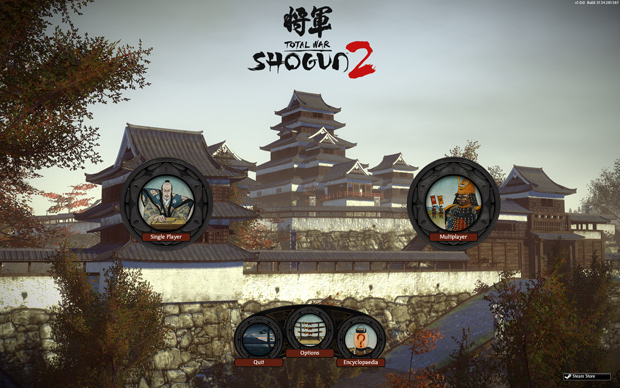
Make no mistake about it: Total War: Shogun 2, available today at fine retailers, both real and digital, is the Total War experience perfected. A tighter, more focused experience all around, Shogun 2 puts you in control of one of nine different clans in 16th century Japan, scheming and warring your way to Kyoto, the home of the ruling shogunate. Will you cover your daimyo in glory, or will your dreams of ruling Japan end in a shameful display?
You’ve done yourself a disservice if you haven’t played a Total War game in recent years. Gameplay consists of two phases: a turn-based (each turn here lasts one season [Winter, Spring, etc.], bringing the total number of turns per year to four) campaign map à la Sid Meier’s Civilization that sees you scrambling for resources, researching technology down two tech trees (Bushido for warfare-related items and Way of Chi for economic and other non-warfare related items), establishing trade routes, and negotiating diplomatic agreements with your rivals; and real-time military clashes between armies and navies that are completely under your control: infantry over here, cavalry over there, missiles in support, etc. It’s quite fun.
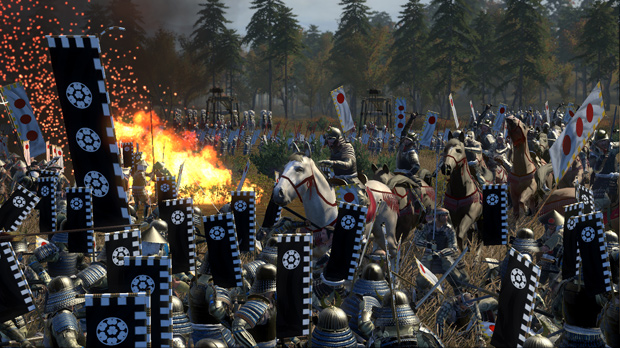
Developed by The Creative Assembly, Total War: Shogun 2 (Sega has switched around the word order—it’s not called Shogun 2: Total War in the vein of Rome: Total War or Empire: Total War— with this release in order to better establish “Total War” as a brand name) takes place during the Sengoku period of Japanese history, which is to say it takes place in the time of the samurai. And I think we can all agree that samurai armor is the best-looking armor in all of human history. Nothing else even comes close.
The goal of Shogun 2 is simple: to establish your clan as the country’s ruling shogunate. Actually accomplishing that goal is another matter entirely.
I’ve been playing the game for the past several days now, but only the single-player mode. It’s sorta difficult to play a multi-player game when the only people who have it are a handful folks from this or that magazine or Web site.
Being confined to the main islands of Japan (though you can establish trade routes with off-map groups like Korea or China), the campaign map is necessarily smaller than it was in Napoleon: Total War and Empire: Total War. (Empire was almost too big for its own good in retrospect.) But just because the map is physically smaller doesn’t mean there’s not a lot going on. There’s 25 separate provinces, and each of these provinces, once under your control, can be built up as you see fit: do you want to create a military stronghold, with samurai schools, war horse stables, and a military port to create a seaworthy navy, or do you want the province to be a money maker with trade ships, rice exchanges, and merchant guilds? Don’t forget to throw in a few sake dens, gambling halls, and Buddhist temples in order to keep the population happy and productive, and to offset the influence of those pesky European missionaries who infiltrate via advanced commercial ports, trying to convert your provinces to Christianity. You don’t want a rebellion on your hands!
The game looks fantastic. That’s a meaningless phrase until you see the improvements made since last year’s Napoleon: Total War.
Look at the detail in the Samurai armor versus my poor old French chasseur from Napoleon: Total War. This is how it looks without Direct X 11, by the way. (A forthcoming patch will bring DX11 support. The Creative Assembly and Sega wanted to take a few extra turns, if you will, polishing the DX11 experience without delaying the release of the game.)
The attention to detail throughout is something else. Cherry blossom petals flutter through the air during springtime battles (battles can take place in any of the four seasons); loading screens and unit cards alongside the bottom of the screen look like watercolor paintings; the “fog of war,” now resembling a felt pen map, obscuring undiscovered provinces peels away as your army or navy approaches, receding again if your army or navy passes by; there’s a familiar “crunch” sound when your armies march on snow during the wintertime; short videos play when your ninja attempts to assassinate a rival daimyo or general, or sabotage the castle gates; an in-game encyclopedia provides all the info you could ever want on the game’s various buildings and units; water actually looks like water!
Naturally this kind of detail means you’ll need a pretty powerful computer to play the game at the highest settings. (The Total War games are notorious for their high system requirements.) I played with every setting set to Ultra and with 4X AA. I have a Radeon 5970 running the 11.4 preview drivers and an Intel Core i7 860 OC’d to 3.8GHz, and while there’s some jitter during the campaign map (just as there was with Napoleon: Total War), battles run as smooth as you like, hovering in the 50 to low 60 fps range. Presumably upcoming patches and GPU driver optimizations will improve performance further still.
Probably the biggest critique of the Total War games has been of its A.I. You know, enemy cavalry running straight into your bayonets (or era equivalent), that sort of thing. I don’t think you’ll find that type of happening as often here. I recall a small battle where I thought I’d be clever by sending my bowmen on top of a hill a little bit forward and to the left of the main enemy line. I was thinking, “Oh, I’ll just walk up this hill, get set up, then rain down a storm of arrows.” Yeah, the patently didn’t happen. As soon as my bowmen were about halfway up the hill the enemy’s cavalry ran up the opposite side, then proceeded to cut my bowmen down like a couple of jerks. I’m reasonably confident that in past Total War games I would have at least been able to open fire before they sent anyone my way. There was another time where I decided to send my cavalry off to the side of the main battle line, where they’d wait for the enemy to approach my line of infantry, then go in and flank them. A fine plan, sure, until the enemy instead walked forward a little bit, then opened fire with their bowmen on my poor cavalry. Once, I had my entire fleet (let’s call it eight ships made up of bow ships and medium-sized bune) surround a European gunboat in a particularly fun battle, and where did it get me? Absolutely nowhere, as the gunboat repelled no less than four boarding attempts.
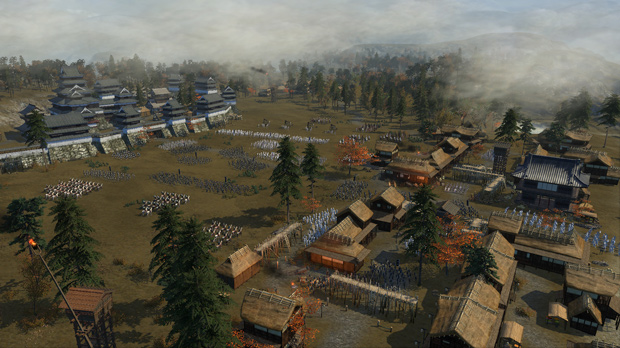
Is the A.I. perfect? No, probably not, but I don’t think it’s as poor as it had been in previous games. (I remember playing the Battle of Bunker Hill in Empire: Total War and scratching my head as to why the British kept walking up the hill despite the fact that I was raining bullets down on them. You’d think they’d try to walk around or something…) Your expectations may vary, of course, but I played on normal difficulty and didn’t think I was waltzing my way to victory. One thing that was odd: there’s no separate battle and campaign difficult slider this time around. That means you can’t, say, have the campaign difficulty set to normal and the battle difficulty set to hard (which I believe is a fairly common setting, judging by various forums and whatnot).
OK, this is getting a little long. The fact is if you’ve ever even halfway liked a Total War game in the past then it’s pretty much guaranteed you’ll be keen on Shogun 2. At the same time, if you never liked the series in the past you’re probably not going to like this—and that’s despite the fact that the default campaign advice bubble pops up entirely too frequently on the default setting, presumably in an effort to ease players into the game—if only because, as stated before, the game represents the complete refinement of the Total War formula.
Anyhow, the launch trailer follows.
http://player.ooyala.com/player.swf?embedCode=lxNWtiMjpaHJ99Q3wot5z2Lt2H0fDyq1&version=2
